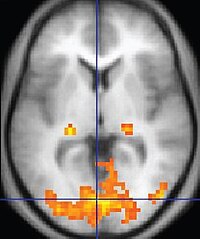
Photo from wikipedia
Benefiting from the research of machine learning (ML) and deep learning(DL), multivariate methods based on ML and DL have been the mainstream and successful analysis methods in Neural Engineering or… Click to show full abstract
Benefiting from the research of machine learning (ML) and deep learning(DL), multivariate methods based on ML and DL have been the mainstream and successful analysis methods in Neural Engineering or Neuroimaging research, for example, assisting diagnosis based on brain Magnetic Resonance Imaging (MRI). However, many existing methods based on traditional ML methods cannot sufficiently extract discriminative features, especially feature patterns across long-distance brain areas, resulting in unsatisfactory classification performance. Designing an effective and robust classifier for different MRI images remains a challenge. In this paper, we introduced dilated 3D CNN method for classifying 3D MRI images combining CNN structure and dilated convolution with a small number of feature maps. We also presented a methodology framework based on dilated 3D CNN method, which can classify both single MRI images and image sequences. Our method and framework were evaluated on the structural MRI images of ADHD-200 dataset and fMRI images of a Schizophrenia dataset, demonstrating better performances than some other state-of-the-art methods.
Journal Title: IEEE Access
Year Published: 2019
Link to full text (if available)
Share on Social Media: Sign Up to like & get
recommendations!